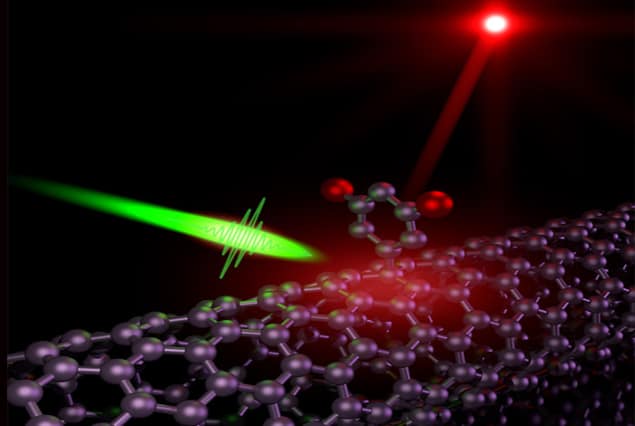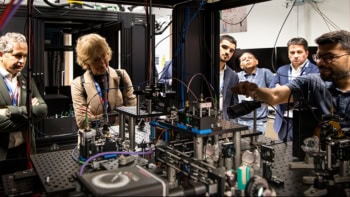
By shining laser light at carbon nanotubes containing special defects, scientists in the US and Japan have taken a step forward in the quest to deliver single photons at room temperature and at wavelengths suited to the telecommunications industry. The technique, which would be a boon for developers of quantum technology, allows the researchers to tune the light emitted by the nanotubes across a range of infrared wavelengths, at some of which they showed room-temperature, single-photon emission.
Single-photon emission is a key component of several quantum-information technologies, in particular quantum communication. If a bit of information is encoded in a laser pulse containing many photons, as is the case conventionally, eavesdroppers can steal information by tapping some of those photons. Attenuating such pulses to the single-photon level might seem a good idea, but it does not completely solve the problem because the laser might emit two photons at the same time.
Other applications to exploit sources of single photons could include quantum computing, where photons would play the role of quantum bits. Quantum metrology, meanwhile, would benefit from a true single-photon source because its signal-to-noise ratio would not be restricted by lasers’ “shot-noise” limit (which is equal to the square root of the laser intensity).
From dots to tubes
The ideal source of single photons is an individual atom. Being a two-level quantum-mechanical system, it emits a single photon when a laser pulse excites a single electron and that electron relaxes down to the ground state. Among the technologies developed to imitate this process is the quantum dot, a tiny piece of semiconductor that can emit single photons by virtue of its atom-like structure of discrete electronic states.
Around 15 years ago, physicists showed that quantum dots made from indium arsenide could emit single photons at telecom wavelengths (1.3 to 1.5 µm). Unfortunately, these devices need to operate at cryogenic temperatures (4 K), making them too expensive for practical use. Nitrogen-vacancy defects in diamond can also generate single photons at room temperature, but unfortunately only at visible wavelengths.
The disadvantage of using carbon nanotubes is that these rolled-up sheets of carbon atoms are one-dimensional and so do not naturally have the energy-level structure of a (zero-dimensional) atom. In the latest work, Stephen Doorn at the Los Alamos National Laboratory in New Mexico and colleagues generate electron–hole pairs known as excitons on the surface of a nanotube using a laser beam, and then trap a single exciton within a defect on the nanotube surface such that the electron drops back to its ground state and emits a single photon.
Dips and wells
Such a scheme was first reported by Atac Imamoǧlu of ETH Zürich and colleagues in 2008. That work exploited very slight dips in electric potential on the surface of carbon nanotubes caused by variations in the nanotubes’ environment when they are stored in a liquid suspension and then dispersed on a substrate. Unfortunately, the dips are just a few milli-electronvolts (meV) deep, which is far less than the thermal energy of an exciton at room temperature. As such, the scheme relied on cooling the nanotubes down to 4 K.
To operate at room temperature, Doorn and co-workers add defects that create much deeper potential wells. They did so first two years ago when they introduced oxygen defects with depths of up to 300 meV. But although they managed to generate single photons at room temperature, they found that the emission was unstable – blinking on and off rather than remaining constant – and were unable to tune the emission to telecom wavelengths.
Benzene and ring
Now the researchers have turned to molecules similar to benzene, a ring of six carbon-hydrogen pairs that form a 130–300 meV-deep pit when attached covalently to a nanotube. By varying a nanotube’s diameter, the nanotube plus ring can be made to emit from 1.15 to 1.6 μm at three wavelengths within the telecom band. They have also shown that the modified nanotubes can generate single photons stably at room temperature at wavelengths less than 1.5 μm. Unfortunately, however, at the wavelength most useful for telecoms applications – 1.55 μm – the tubes had to be held at 220 K.
The researchers needed this lower temperature to compensate for detection inefficiencies at longer wavelengths. High efficiencies are important because the process used to demonstrate single-photon emission – spreading out the incident laser pulses in time and then measuring the time delay between successive emitted photons – is very drawn out. But group member Han Htoon] of Los Alamos maintains this problem should not hold them back for long, given the existence of more efficient detectors on the market. “There is no fundamental reason why we couldn’t operate at room temperature,” he says.
Indeed, Milos Toth of the University of Technology Sydney in Australia reckons the latest work “looks like a promising path to practical devices”. But he adds that other technologies, including novel 2D materials and more conventional semiconductors being studied by his group, are also in the running. “It’s not yet clear which material system will prevail,” he says.
Beyond raising efficiencies, Doorn and colleagues will have to show that they can drive the nanotube emitters electrically so as to make chip-mountable devices, with their existing laboratory experiment being driven by a laser that occupies half of an optical bench. “We expect that we can demonstrate an electrically driven photon source within a year or two,” says Htoon. “But integration into a photonic network will take a bit longer.”
The research is published in Nature Photonics.



